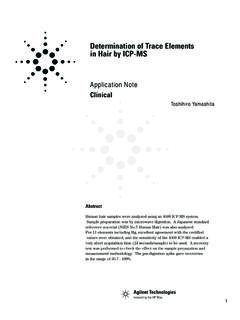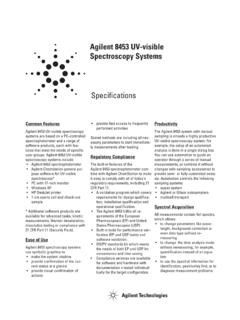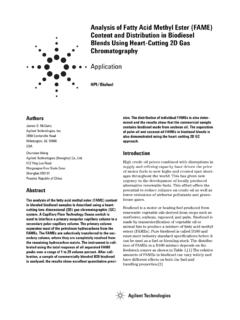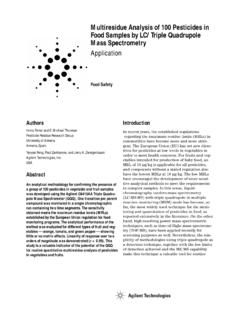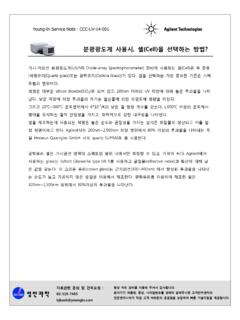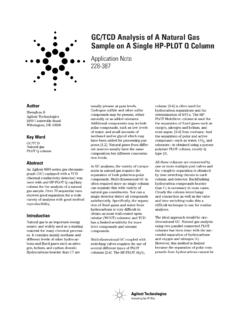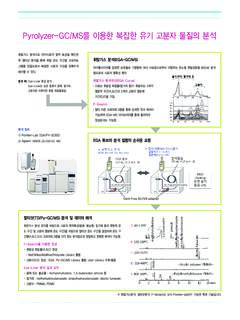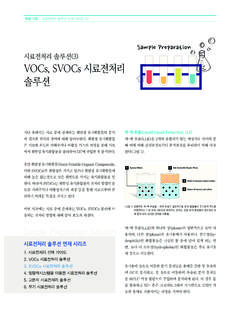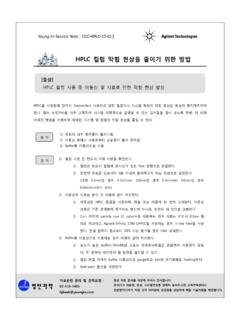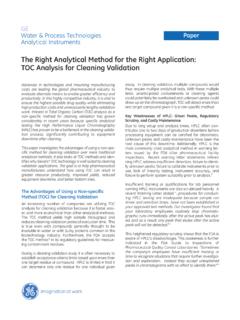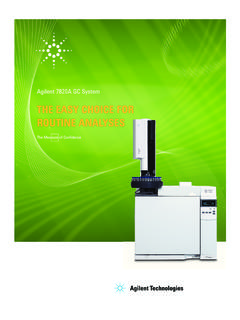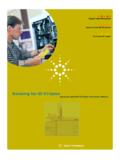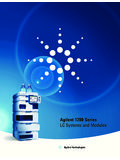Transcription of Analysis of Triglycerides by Liquid …
1 Analysis of Triglycerides by LiquidChromatography/ mass SpectrometryApplicationAuthorHiroki KumagaiAbstractTriglycerides were readily analyzed using Liquid chromatography / mass spectrometry with atmosphericpressure chemical ionization in positive ion is a primary component of many foods, such as cook-ing oils and dairy products. Consequently, it is desirableto conduct compositional analyses of oil-based fatty acidcomponents in food. Such analyses may use either gaschromatography (GC) or high-performance Liquid chro-matography (HPLC), but the GC methods have problemswith the complexity of sample preprocessing, whichrequires HPLC a direct Analysis is possible; however, thesemethods are low in sensitivity because the compoundsof interest do not absorb ultraviolet and separation isbarely adequate.
2 In this study, six Triglycerides (Table 1) with identicalfatty acid compositions were analyzed using Liquid chro-matography/ mass spectrometry (LC/MS) and atmos-pheric pressure chemical ionization (APCI) as theionization Instrument: Agilent 1100 LC/MS with APCI in posi-tive modeMass range: 100 to 1000 m/zDrying gas: N24 L/min, 350 CNebulizer: N250 psiFragmentor: 160 VVaporizer: 400 C LC Conditions:Mobile phase: (CH3)2CO/H2O (98/2)Flow rate: mL/minOven temperature: 40 CInjection volume: 15 L Column: Develosil ODS OG-3, mm id 75 mm longFoodCH2 OCO R1CH OCO R2CH2 OCO R3 triglyceride R1=R2=R3 Trilaurin C11 Trimyristin C13 Tripalmitin C15 Tristearin C18 Triolein C18:1 Trilinolein C18.
3 2 Table Structure of i istearinFigure 1. TIC of triglyceride standards, each at 250 350 450 550 650 750 2. mass spectra of individual triglyceride standards at 250 350 450 550 650 750 (MH)+150 250 350 450 550 650 750 250 350 450 550 650 750 250 350 450 550 650 750 250 350 450 550 650 750 tallest peak in each case represents the [MH-HOOCR]+ion created after the loss of a fatty acidgroup from the protonated psuedomolecular ion.
4 Withthe exception of Trilinolein, the protonated psuedomol-ecular ion was not following figures show total ion chromatogram (TIC)and selected ion mode (SIM) chromatograms, and massspectra for the selected triglyceride 3. SIM chromatograms of individual triglyceride standards at 1 protonated molecular ions were rarelyobserved trilinolein in the scan mode is theexception and the base peaks consisted of fragmentedions from which fatty acid had been was favorable, extending down to ppm inTIC mode.
5 In the SIM mode, measurements at 1 ppbwere possible by selecting the base peak in the massspectrum of each composition of monitored ions. Withthis technique, it is possible to measure fat-soluble sub-stances such as Triglycerides with a high degree of , with APCI in positive ion mode, readily detectedselected triglyceride standards with high analytical peaks were the positvely charged frag-mented ions from which fatty acid had been mode yielded sensitivity to 1 Kumagai is an application chemist atAgilent/Yokogawa Analytical Systems, Tokyo.
6 Technologies shall not be liable for errors contained herein or for incidentalor consequential damages in connection with the furnishing, performance, or use ofthis , descriptions, and specifications in this publication are subject to changewithout 2001 Agilent Technologies, in the USAO ctober 9, 20015988-4235EN
